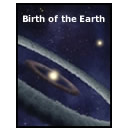Art Sleuth
Using unique detective-like approach the author analyzes famous artworks of Van Gogh, Manet, Botticelli, Vigee Le Brun, Rembrandt, Holbein, Bellini, Carpaccio, and Bruegel.
Van Gogh painted "The Starry Night" in a sanatorium, a year before he committed suicide. While his fellows surrender to the city's glamour and excitement, Van Gogh abandons Paris and gives us distressed urbanite's dream.
Is his frenetic perspective of night and stars simply that, a yearning for the past? Is his picture an impulsive display of madness? Van Gogh's nightscape is made in 1889 - when astronomy is attracting dilettante fans, animated by a series of prominent handbooks, including the first-ever pictures of the night sky. The spiral on the Gogh's painting is in fact an interpretation of real nebula. Venus, which is also included in the painting, was atypically bright that year and the moon is depicted as the painter might have observed it from his cell... before dawn on 25 May 1889.
But the view from Van Gogh's window is just partial, so he creates a landscape, appending cypress and a village tower, which give the painting depth and structure. And even the turbulent nebula focuses on the far horizon, directly below it. If rationality guides the composition, certainly insanity leads the unstable brushwork? Van Gogh is working incredibly fast so he manages to leave parts of the canvas unpainted.
His paintwork fortifies the disparity between the painting's two halves. At the bottom, the houses are silhouetted in black, the trees look like dense hair, and the earth has a sculpted compactness, while the sky spins around and rises, and the light from the stars disperses outward in concentric waves.
In short, the painting's vibrant motion is a purposeful consequence, and Van Gogh uses it to generate strong contrast between the earth's physical firmness, and the sky's wave-like movement. Thick as mud, dynamic as fire, the cypress links the two halves of the painting like a bridge. But why Van Gogh put all this turmoil into a likely tranquil nightscape?




Is that a real photograph?
It looks more like a painting to me.
This may be a Picasso................
Not the most thorough view of VanGogh and he gets a little lost in his own analysis at the end, but he does bring out some fine background and context for Stary Night
I've always wanted to examine this painting. The fact there's lots of blank, unpainted canvas used a as color is new, and a revelation, to me.
I thoroughly enjoyed it. I love artistic analysis. More stuff of this sort please.
Seems a little pointless to have subtitles cluttering up the frame and getting in the way in a doc about pictures, especially when the narrator is speaking so clearly. Even the opening title gets a subtitle.
Never heard of people with hearing problems?
I wonder if he was inspired by El Greco's landscape, at least his sense of perspective is better than the old Romans.